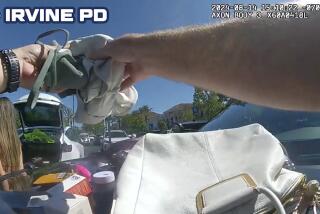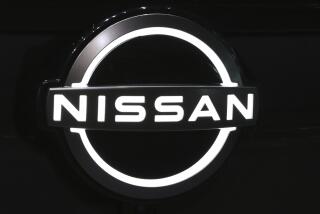Owner Needs a Sentinel for the Sentra
- Share via
Question: I have a 1984 Nissan Sentra. The trunk has been broken into repeatedly. I have talked with a number of other Nissan Sentra owners who have had the same experience. We think thieves must pick out our cars. What do you think?--R.G.
Answer: The problem with Nissan Sentra trunks is well known among auto-theft experts. In Los Angeles, the auto-theft capital of the nation, police detectives say that the Sentra is among a group of cars known as easy targets for teen-age thieves.
The problem is that the latch that holds the trunk lid shut is located directly at the lock barrel, making it relatively easy to pop open.
Nissan officials say they aren’t aware of any particular problem that Sentras have with trunk break-ins. They suggest that if motorists are having a problem with trunk thefts, it could be related to the fact that many young people own the car and that they tend to park in high-crime areas.
But on the road, you can see that a disproportionate share of Sentra trunk locks have been bent as the presumed result of break-in attempts. The fact that the sheet metal is of a very light gauge makes defeating the lock all the easier. Some early Toyotas had the same problem.
In general, Japanese-made cars are less resistant to thieves than American-made cars. Unfortunately, the reason seems to be that in this country we have a bigger problem with street crime, so American producers have more experience in building stronger locks.
Trunk locks that are more theft resistant have a cable mechanism that connects the lock barrel to the trunk latch. You can easily identify these kinds of locks because the key-entry point is well below the edge of the trunk.
There are a few things you can do. Some Sentra owners simply have removed the lock altogether, leaving a hole where the lock is mounted and never storing anything of value in the trunk. Other owners have used a circular reinforcement ring that attaches around the lock and helps prevent the sheet metal from deflecting. It doesn’t look very good, but apparently it works.
Q: I have a 1980 Fairmont with an 8-cylinder engine that is very difficult to get into drive the first time in the morning. I can back out of the drive, but it won’t go forward. It seems to help if I rev up the engine. Any suggestions?--L.R.J.
A: You have the classic symptoms of low automatic transmission fluid. If the fluid becomes low enough, the torque converter cannot transfer power from the engine to the transmission. The converter is a fluid clutch and depends on an adequate amount of fluid to work properly.
You should check the transmission dip stick immediately. A low transmission fluid level can seriously damage the transmission. The fluid should be a clear red color. If it looks or smells burnt, you may have additional problems, such as a bad clutch pack. In that case, get the car to a mechanic before you trash your entire transmission.
Q: You recently wrote about solar-reflective films for car windows. I covered the windows on my station wagon in 1980, and so far they haven’t faded, cracked or peeled. It is vital that a squeegee be used to smooth the film and remove any bubbles. Afterward, I applied a coat of varnish around the edges.--C.D.R.
A: You must do top-quality work. You ought to open a window-tinting business, because your solar film has held up longer than most manufacturers say it will, and a lot longer than many professionally applied films.
Vartabedian cannot answer mail personally but will respond in this column to automotive questions of general interest. Do not telephone. Write to Your Wheels, You section, The Times, Times Mirror Square, Los Angeles 90053.







